A PRIEST METHODICALLY REVEALS
UKRAINIAN JEWS' FATE
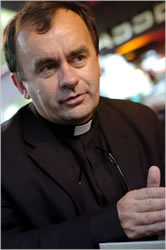 |
Patrick Desbois, a Roman Catholic priest from France, has spent four years hearing witnesses' accounts and searching for unmarked common graves in Ukraine, where 1.5 million Jews were shot dead by Nazis from 1941 to 1944 and buried throughout the country.Photo: Antoine Antoniol for The New York Times
|
His subjects were mostly children and teenagers at the time, terrified witnesses to mass slaughter. Some were forced to work at the bottom rung of the Nazi killing machine — as diggers of mass graves, cooks who fed Nazi soldiers and seamstresses who mended clothes stripped from the Jews before execution.
They live today in rural poverty, many without running water or heat, nearing the end of their lives. So Patrick Desbois has been quietly seeking them out, roaming the back roads and forgotten fields of Ukraine, hearing their stories and searching for the unmarked common graves. He knows that they are an unparalleled source to document the murder of the 1.5 million Jews of Ukraine, shot dead and buried throughout the country.
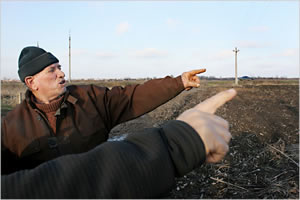 |
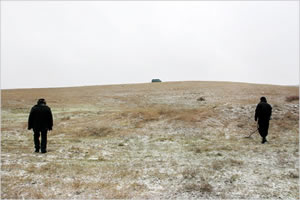 |
In the village of Konstantinovka, witnesses to killings
showed where to find mass graves .Photo: Guillaume Ribot/Yahad-In Unum |
A research team directed by Father Desbois used
metal detectors to find bullets and cartridges, which help locate the graves. Photo: Guillaume Ribot/Yahad-In Unum |
He is neither a historian nor an archaeologist, but a French Roman Catholic priest. And his most powerful tools are his matter-of-fact style — and his clerical collar.
The Nazis killed nearly 1.5 million Jews in Ukraine after their invasion of the Soviet Union in June 1941. But with few exceptions, most notably the 1941 slaughter of nearly 34,000 Jews in the Babi Yar ravine in Kiev, much of that history has gone untold.
Knocking on doors, unannounced, Father Desbois, 52, seeks to unlock the memories of Ukrainian villagers the way he might take confessions one by one in church.
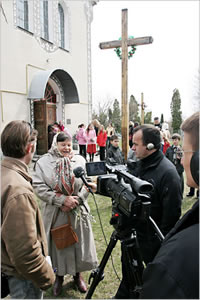 |
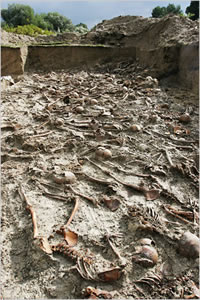 |
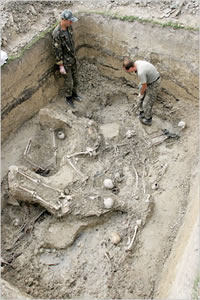 |
Over four years, Father Desbois, second from right, has videotaped more than 700 interviews with witnesses and bystanders and identified more than 600 common graves of Jews, most of them previously unknown.Photo: Guillaume Ribot/Yahad-In Unum
|
One of 15 mass graves excavated under the direction of Father Desbois. "There was nothing to see in Ukraine because people were shot to death with guns," said Thomas Eymond-Laritaz, president of the Victor Pinchuk Foundation, Ukraine's largest philanthropic organization. "That's why Father Desbois is so important."Photo: Guillaume Ribot/Yahad-In Unum
|
In August 2006, Father Desbois's team uncovered a mass grave near the village of Busk. With few exceptions, most notably the 1941 slaughter of nearly 34,000 Jews in the Babi Yar ravine in Kiev, much of the killing history has gone untold.Photo: Guillaume Ribot/Yahad-In Unum |
“At first, sometimes, people don’t believe I’m a priest,” said Father Desbois in an interview this week. “I have to use simple words and listen to these horrors — without any judgment. I cannot react to the horrors that pour out. If I react, the stories will stop.”
Over four years, Father Desbois has videotaped more than 700 interviews with witnesses and bystanders and has identified more than 600 common graves of Jews, most of them previously unknown. He also has gathered material evidence of the execution of Jews from 1941 to 1944, the “Holocaust of bullets” as it is called.
Often his subjects ask Father Desbois to stay for a meal and to pray, as if to somehow bless their acts of remembrance. He does not judge those who were assigned to carry out tasks for the Nazis, and Holocaust scholars say that is one reason he is so effective.
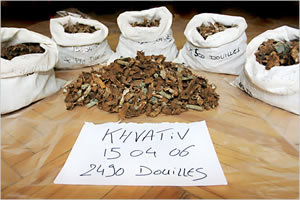 |
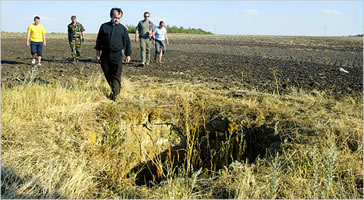 |
Father Desbois's team found 2,490 bullet cartridges
near a village in April 2006.Photo: Guillaume Ribot/Yahad-In Unum |
Father Desbois and his team have been quietly seeking witnesses, roaming the back roads and forgotten fields of Ukraine. His most powerful tools are his matter-of-fact style,
and his clerical collar. Photo: Efrem Lukatsky/Associated Press |
“If a Jewish taker-of-testimony comes, what would people think — that this is someone coming to accuse,” said Paul Shapiro, director of the Center for Advanced Holocaust Studies at the United States Holocaust Memorial Museum in Washington. “When a priest comes, people open up. He brings to the subject a kind of legitimacy, a sense that it’s O.K. to talk about the past. There’s absolution through confession.”
Unlike in Poland and Germany, where the Holocaust remains visible through the searing symbols of the extermination camps, the horror in Ukraine was hidden away, first by the Nazis, then by the Soviets.
“There was nothing to see in Ukraine because people were shot to death with guns,” said Thomas Eymond-Laritaz, president of the Victor Pinchuk Foundation, Ukraine’s largest philanthropic organization. “That’s why Father Desbois is so important.”
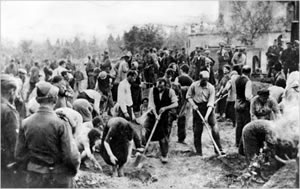 |
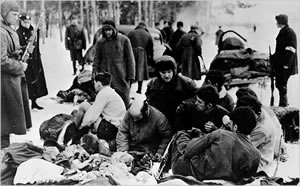 |
Members of an unidentified German paramilitary group, operated by the Nazis, watched as Jewish men and women were forced to dig their own graves. Many Ukrainians were forced to carry out tasks for the Nazis.Photo: The Federal Archive of Koblenz, Germany
|
Jewish prisoners were forced to undress before they were executed in Chernigov, Ukraine, in 1942. Some villagers had to feed Nazi soldiers, and others had to mend the clothes stripped from Jews.Photo: United States Holocaust Memorial Museum
|
The foundation helped underwrite a conference on the subject at the Sorbonne this week — the first to bring together Western and Ukrainian scholars — and has begun contributing funds to Father Desbois’s project.
Some of the results of Father Desbois’s research — including video interviews, wartime documents, photographs of newly uncovered mass graves, rusty bullets and shell casings and personal possessions of the victims — are on display for the first time at an exhibit at the Memorial of the Shoah in the Marais district of Paris.
The exhibit shows, for example, images of the 15 mass graves of several thousand Jews in a commune called Busk that Father Desbois and his team discovered and began excavating after interviewing several witnesses. Among hundreds of other items on display is a black-and-white photo from 1942 that shows a German police officer shooting naked Jewish women lying in a ravine in the Rivne region.
Traveling with a team that includes two interpreters, a photographer, a cameraman, a ballistics specialist, a mapping expert and a notetaker, Father Desbois records all the stories on video, sometimes holding the microphone himself, and asking questions in simple language and a flat tone.
In Buchach in 2005, Regina Skora told Father Desbois that as a young girl she witnessed executions.
“Did the people know they were going to be killed?” Father Desbois asked her.
“Yes.”
“How did they react?”
“They just walked, that’s all. If someone couldn’t walk, they told him to lie on the ground and shot him in the back of the neck.”
Vera Filonok said she was 16 when she watched from the porch of her mud hut in Konstantinovka in 1941 as thousands of Jews were shot, thrown into a pit and set on fire. Those who were still alive writhed “like flies and worms,” she said.
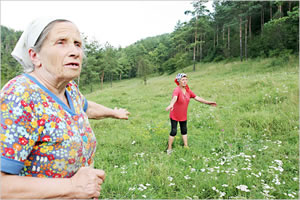 |
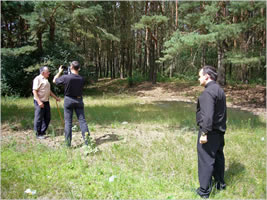 |
Two witnesses gestured to the location of a mass
grave near Naraiv. Often his subjects ask Father Desbois to stay for a meal and to pray, as if to somehow bless their acts of remembrance. Photo: Guillaume Ribot/Yahad-In Unum |
Father Desbois, right, and a cameraman prepared to interview
a witness last summer. Father Desbois does not judge those who were assigned to carry out tasks for the Nazis, and Holocaust scholars say that is one reason he is so effective. Photo: Pierre-Philippe Preux/Yahad-In Unum |
There are stories of how the Nazis drummed on empty buckets to avoid having to listen to the screams of their victims, how Jewish women were made sex slaves of the Nazis and then executed. One witness said that as a 6-year-old he hid and watched as his best friend was shot to death.
Other witnesses described how the Nazis were allowed only one bullet to the back per victim and that the Jews sometimes were buried alive. “One witness told of how the pit moved for three days, how it breathed,” Father Desbois recalled.
Father Desbois became haunted by the history of the Nazis in Ukraine as a child growing up on the family farm in the Bresse region of eastern France. His paternal grandfather, who was deported to a prison camp for French soldiers in Rava-Ruska, on the Ukrainian side of the Polish border, told the family nothing about the experience. But he confessed to his relentlessly curious grandson, “For us it was bad, for ‘others’ it was worse.”
There were other family links to the German occupation of France. One maternal cousin who carried letters for French resisters perished in a Nazi concentration camp. Father Desbois’s mother told him only recently that the family hid dozens of resisters on the farm.
After teaching mathematics as a French government employee in West Africa and working in Calcutta for three months with Mother Teresa, he joined the priesthood. His secular family was horrified.
He started as a parish priest, studying Judaism and learning Hebrew during a stint in Israel. He asked to work with Gypsies, ex-prisoners or Jews, and was appointed as a bridge to France’s Jewish community.
It was on a tour with a group in 2002 that, visiting Rava-Ruska, he asked the mayor where the Jews were buried. The mayor said he did not know.
“I knew that 10,000 Jews had been killed there, so it was impossible that he didn’t know,” Father Desbois recalled.
The following year, a new mayor took the priest to a forest where about 100 villagers had gathered in a semicircle, waiting to tell their stories and to help uncover the graves buried beneath their feet.
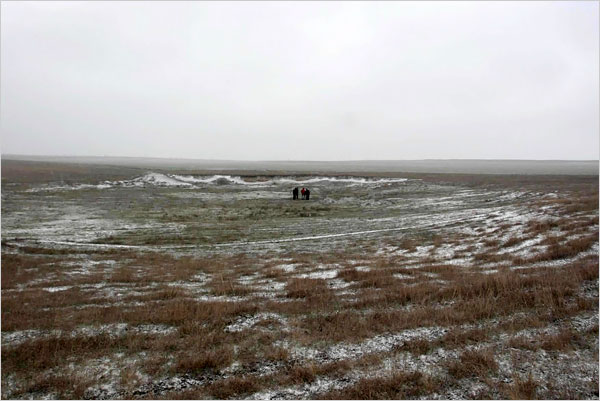 |
Only one-third of Ukrainian territory has been covered so far, and it will take several more years to finish the research.
Photo: Guillaume Ribot/Yahad-In Unum |
He met other mayors and parish priests who helped find more witnesses. In 2004, Father Desbois created Yahad-In Unum, an organization devoted to Christian-Jewish understanding run from a tiny office in a working-class neighborhood in northeastern Paris, backed and largely financed by a Holocaust foundation in France and the Catholic Church.
To verify witnesses’ testimony, Father Desbois relies heavily on a huge archive of Soviet-era documents housed in the Holocaust museum in Washington, as well as German trial archives. He registers an execution or a grave site only after obtaining three independent accounts from witnesses.
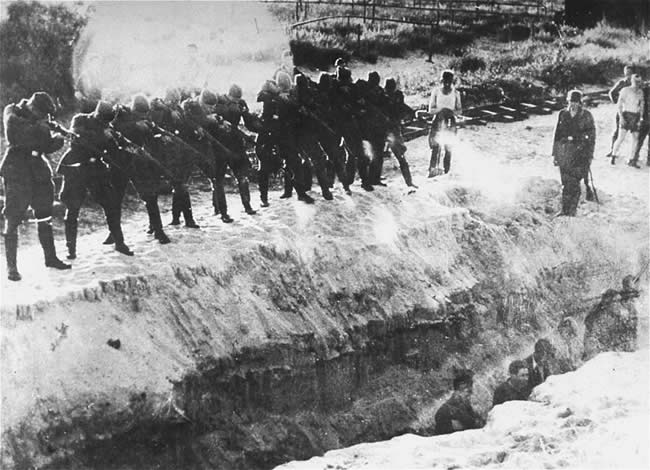 |
Members of an Einsatzkommando firing at men standing at the bottom of a trench. Circa : 1941-1942. Whereabouts unknown. Photographer unknown. Courtesy of Dokumentatioarchiv of the Oesterreichischen Widerstandes |
Only one-third of Ukrainian territory has been covered so far, and it will take several more years to finish the research. A notice at the exit of the Paris exhibit asks that any visitor with information about victims of Nazi atrocities in Ukraine leave a note or send an e-mail message.
“People talk as if these things happened yesterday, as if 60 years didn’t exist,” Father Desbois said. “Some ask, ‘Why are you coming so late? We have been waiting for you.’”